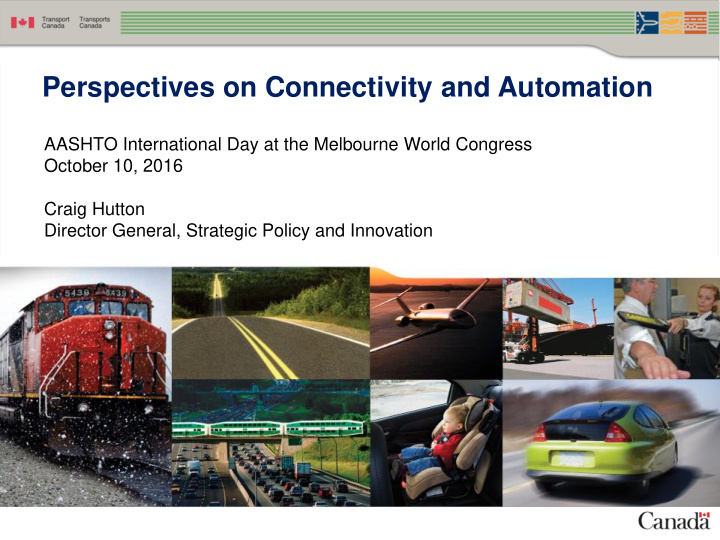



Perspectives on Connectivity and Automation AASHTO International Day at the Melbourne World Congress October 10, 2016 Craig Hutton Director General, Strategic Policy and Innovation
The future of transportation: technology inspiring innovation “We stand on the brink of a technological “90% of the data in the world today has been created in the last two years alone.” revolution that will fundamentally alter the way we live, work, and relate to one another.” – IBM – World Economic Forum “The Internet has revolutionized the way we “…a revolutionary new form of transportation that’s one communicate. Can you part Concorde, one part railgun, and one part air hockey imagine what it can do for table…it could forever change the way we think about the supply chain? The transportation .” – Elon Musk (about Hyperloop) Transport and Logistics “I believe the auto industry will Internet is coming …it is a game changer.” – change more in the next five to 10 years than it has in the last 50 …” Jeremy Rifkin, renowned – Mary Barra, CEO, General Motors economic and social theorist “… new business models and “ The transportation industry is on the verge of a technologies are emerging to massive software-driven market disruption , solve the mobility challenge.” setting the stage for a significant change in the way – McKinsey & Company we think about travel, city design, and transport more broadly.” – Marc Andreessen, Entrepreneur 2
Connectivity and automation will have far reaching impacts on the transportation sector, and the economy as a whole Connectivity Large-scale exploitation of information and communication technologies Automation Growing emphasis on digitization, data and analytics Intelligent, sensor-based infrastructure Internet of Things Overall movement towards the creation of “smart” cities New players, business models and Cloud Technology urban mobility solutions Car of the Future Adapted from McKinsey Global Institute 3
Canadian context: key anticipated benefits of CVs and AVs • Efficiency: Economic cost of traffic congestion costs Canadian economy more than $6 billion annually. CV/AVs will help increase competitiveness by reducing transportation costs and decreasing congestion Connected vehicle safety warning • (US DOT) Safety: Over 500,000 motor vehicle collisions annually, resulting in more than 1,800 fatalities in Canada. CV/AVs will improve road safety by significantly reducing severity of these collisions • Environment: CV/AVs have potential to reduce Automated platooning to reduce fuel consumption and emissions environmental impacts by improving traffic flows, and movement of goods/people • Accessibility and Mobility: AVs will improve the access to transportation and mobility of Canadians who cannot drive a vehicle, including individuals with disabilities 4 Smart infrastructure to manage congestion and improve traffic flows
Canadian context: key considerations for success • Collaboration will be key: Canada must work both internationally and continentally to develop standards, regulations and deployment approaches • Government has a role to play : Critical role with respect to national and continental interoperability, stakeholder coordination, regulations, privacy, safety, cybersecurity and infrastructure readiness • Canada has cutting-edge capabilities : Establish strong competitive position by building on key areas of strength, including our world-class automotive facilities, and information technology and clean technology sectors 5
Forging a common approach across provinces within Canada Council of Ministers Canadian Council of Motor Transportation for Transportation Transport Administrators Association of Canada Supporting complementary Encouraging national Addressing CV/AVs in the approaches to enhance consistency in addressing the context of smart infrastructure readiness for CV/AVs testing and use of CV/AVs needs Advance opportunities Best practices for Provide guidelines for and address challenges jurisdictions to implement jurisdictions to help related to policy testing legislation and conduct pilot deployment frameworks address operational projects aspects such as vehicle Collaboration between Disseminate knowledge registration/licensing industry, academia and and work collaboratively governments with road transport operators, including cities 6
Supporting Canadian centres of expertise Transport Canada’s Motor Vehicle Test Centre • Leader in testing in North America – supports development of guidelines, standards, regulations and crash countermeasures • Conducting research on crash avoidance and human factors needs – sharing results with industry Waterloo Centre for Automotive Research • Canada’s largest automotive– academic enterprise with synergy across IT and automotive clusters • Developing real-time communication solutions for seamless connectivity between vehicles, infrastructure, wireless devices Active-Aurora Project • Unique partnership among governments, academia and industry, consisting of 4 test-beds and 2 laboratory test environments • Evaluating CV technologies for safety and traffic management, and wireless communications for freight security and efficiency 7
Working with leading countries internationally G7 Working Group on CV/AVs • Declaration on automated and connected driving – coordinating research, promoting international standards, and evolving technical regulations within an international framework Canada-United States Regulatory Cooperation • CVs: joint planning and priority-setting, collaborative research projects, information exchanges and standards development • Motor Vehicle Safety Standards: supporting development of human factors design principles for driver-vehicle interfaces 8
Promoting transportation innovation in support of a long-term agenda for transportation in Canada Enhancing focus on new Establishing progressive and and disruptive technologies coordinated policy frameworks Test, pilot and Better integrating scale technology governments’ work demonstration & with industry and deployment academia Leveraging economic and Strengthening domestic and social potential with the need international cooperation on for ongoing safety and security transport technology issues 9
Concluding comments • Technology deployment and data-driven initiatives have the ability to contribute solutions to today’s transportation system challenges • New possibilities for transportation are being created through integration of technological innovation with existing systems to drive improvements to safety and efficiency, environmental sustainability, expansion of mobility, and opportunities for growth, jobs and investments • Policy, regulatory and deployment issues will continue to be key considerations with the emergence of new transportation technologies 10
Thank you! Contact information: Craig Hutton Director General, Strategic Policy and Innovation Transport Canada craig.hutton@tc.gc.ca 11
Recommend
More recommend